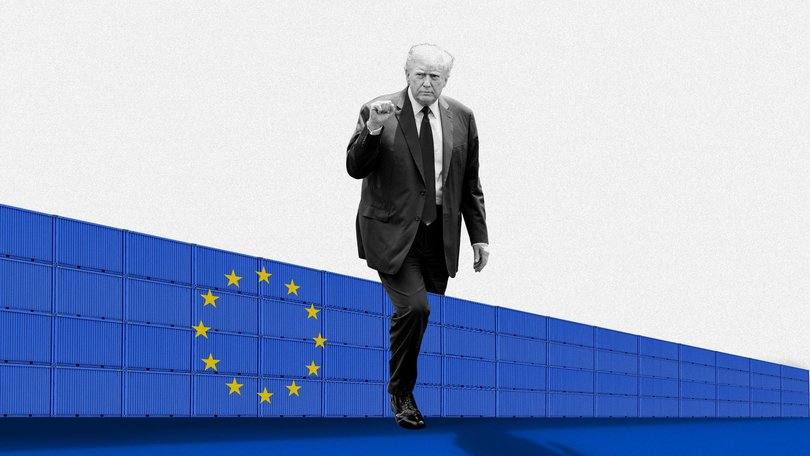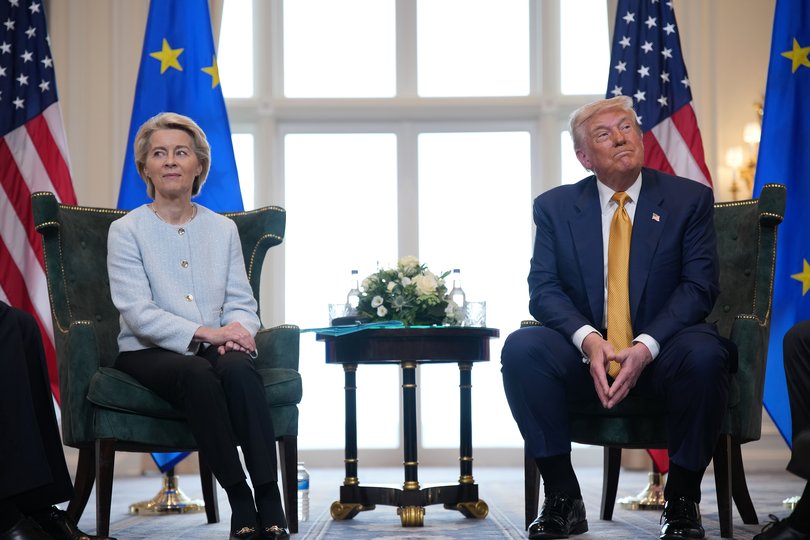EU-US trade deal: Donald Trump’s latest deal reveals the tariff shakedown

Trump’s global tariff shakedown is gaining pace.
The latest to fold is the EU — despite being Trump’s most powerful economic equivalent.
With the EU’s capitulation, Trump’s tariff steamroller now faces little resistance, leaving China as the only nation with any negotiating power.
Sign up to The Nightly's newsletters.
Get the first look at the digital newspaper, curated daily stories and breaking headlines delivered to your inbox.
By continuing you agree to our Terms and Privacy Policy.Australia’s 10 per cent appears assured, but it wouldn’t surprise if Trump, emboldened by how easily countries have fallen, decided to lift the baseline tariff to 15 per cent.
That would make Labor’s inability to strike a deal, unlike ally and net importer the UK, a costly mistake.
EU had the power to push back
Two-way trade between the US and EU totalled €1.6 trillion ($2.9 trillion) in 2023, with the EU coming out in front by just 3 per cent of the total.
The EU exported €503 billion in goods to the US in 2023, compared to €347 billion in US goods heading the other way.
In services, it was the reverse: Europe sent €319 billion to the US and imported €427 billion.
The EU had the economic power to put serious pressure on America in this negotiation but chose to fold.
That was perhaps no better indication of how pathetic the EU appeared, than for European Commission president Ursula von der Leyen agreeing to travel to Trump’s private golf course in Scotland to fit in trade talks around the President’s golf schedule.
While Donald Trump is the cat that got the cream, President von der Leyen looked like a foie gras goose who’d just been force fed gruel one time a day, rather than the standard two.
The deal, such as it is, reduces the 30 per cent tariff on most European goods to 15 per cent, including pharmaceuticals and cars, which previously had a levy of 27.5 per cent. The EU will also address the “overcapacity” in the steel sector by placing a quota on its own factories.
It will also spend $US750b over the next three years buying US oil and gas as it pivots away from Russian supply.
Ms von der Leyen described Trump as “a tough negotiator but also a deal maker.”
He sure is.

The US gets $90b of tariff revenue off European imports, and the EU gets “more predictability in these turbulent times to plan and invest” and as well as “tariff relief”, they also get American AI chips so essential for moving away from low-margin manufacturing.
“With this deal we are securing access to our largest export market; at the same time we will give better access for American products for our market. This will benefit European consumers and make our businesses more competitive,” Ms von der Leyen said.
Read that sentence again. In this “biggest deal ever struck”, the EU will allow unfettered access for American goods to enter the bloc, while European companies are effectively subsidising American manufacturers by shaving their margins to compete on a tilted playing field.
And this is supposed to make European businesses “more competitive”?
If anything, it exposes the fragility of the European economy.
Certainly its inability to plan for a net zero energy grid that has made it dependent on imported energy, and reliant on bad faith partners.
Cars are the canary in the coal mine
But it’s the car industry that seems a key point of leverage.
A strong automative sector is regarded as the apex of manufacturing prowess, which is why autoworkers were the only blue-collar industry to get a seat at the Liberation Day tariff announcement.
But the shifting nature of the car business is an example of why Trump can so easily get trading partners over a barrel, as this heavily unionised, politically powerful industry faces an existential threat.
Government handouts keep carmakers going worldwide, but none can compete with the might of the state industrial complex in China, which has invested so much in the industry that it is now has enough capacity to meet half the world’s demand.
So cut-throat is China’s car industry that just 10 per cent of 129 current EV brands are expected to make a profit in the next five years.
And while China has been growing its domestic capacity, Europe has been giving it a leg up with its net zero ambitions, all while local manufacturers have been caught napping.
Chinese EV makers now account for 40 per cent of Europe’s car imports. And the rise of luxury Chinese models has begun to eclipse premium brands like BMW and Mercedes — particularly in China, once their most lucrative market. China had accounted for as much as one-third of European car exports.
The EU automotive industry employs nearly 14 million people, or 6.1 per cent of the total EU workforce. There are 255 automotive plants across the region and in Slovakia, Romania, Sweden, Czech Republic, Hungary and in Germany it makes up 10 per cent of the total manufacturing employment.
Japan is no stranger to Chinese carmakers eating their lunch, which is why they were so desperate to also ink a 15 per cent trade deal that would cut the tariff on Japanese cars from 27.5 per cent. As a sweetener to America, Japan pledged $US550 billion for US-based auto investment — where Trump claimed the US would pocket 90 per cent of the profits.
A plan to stop China — that helps it
The irony is that the focus of tariffs was supposed to be curbing China.
In the original Project 2025 blueprint for the US administration, China was public enemy number one.
The rapid rise of its industrial base was seen as a threat to US hegemony, and trade sanctions were intended to reshore manufacturing, bringing the US back to an industrial might equivalent to World War 2.
But China’s ascension has been at the expense of the manufacturing dominance of Germany, Japan and Korea. It would seem they have been so hollowed out by Chinese competition that countries can’t afford not to do a deal with the US.
Rather than contain China, so far Trump’s strategy has divided its competitors — and turned them into reluctant funders of America’s industrial revival.
It’s turkeys voting for Christmas, as it doesn’t deal with the threat of China going away, but limits the ability of firms to invest in innovation, given up to 15 per cent of their margin must now go to paying a toll to the US government.
And even if the company itself doesn’t eat all of that margin, someone is.
In Europe, Japan and elsewhere, expect taxpayers to have to fork out more in subsidies to prop up firms who now face lower profitability.
Alternatively, the 15 per cent is split between the US consumer and the foreign importer. That just means 7 per cent comes out of US citizens’ pay packets and probably more as domestic firms raise their prices to the level of tariffs.
Whatever happens, the US Government is squeezing either allies or its own people to partly pay for tax cuts that reduce incomes of the poorest 40 per cent of Americans and put more money into the pockets of the richest. By one estimate, the One Big Beautiful Bill tax cuts are equivalent to gifting $296,000 annually to every taxpayer earning over $US5 million, and $55,300 to taxpayers earning between $1m and $5m.
China next
While von der Leyen flew to Trump’s private golf course, Trump is still angling for a meeting with Xi Jinping.
Officials will meet in Sweden next month to try to avoid the 100 per cent plus tariff standoff that would be disastrous for global trade.
It shows that China’s leadership studied the art of the deal. They cornered the rare earths market and are using it as a bargaining chip to get access to American microchips.
And Trump knows he can’t get the interest rate cuts he needs to refinance America’s massive debt without cheap Chinese goods bringing down inflation.
Given that standoff, it seems unlikely Trump will be successful in neutering China’s industrial might to bolster America’s.
Which means the whole tariff plan becomes a revenue squeeze on everyone else.
Australia must hope that the rank capitulation by friends and allies hasn’t emboldened Trump to jack up the tariff to 15 per cent.

